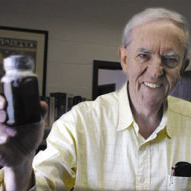Bill Starnes' Patent Promises Better Plastic Along with Safer World
 What excites Floyd Dewey Gottwald, Sr. Professor of Chemistry
William Starnes most about his recently patented organic stabilizers
for PVC isn't the tremendous monetary potential the invention could
bring him, the College and his department. It's the idea that his
contribution to the growing $1.8-billion heat stabilizers industry
could help save lives.
What excites Floyd Dewey Gottwald, Sr. Professor of Chemistry
William Starnes most about his recently patented organic stabilizers
for PVC isn't the tremendous monetary potential the invention could
bring him, the College and his department. It's the idea that his
contribution to the growing $1.8-billion heat stabilizers industry
could help save lives.
One of the most widely used plastics in the world, PVC, or poly(vinyl chloride), has been attacked for its potentially adverse environmental effects. When heated, PVC tends to degrade. To prevent this degradation, heat stabilizers are added to the polymer. Until now, the problem has been that the best, most effective stabilizers contain heavy metals which are often toxic and environmentally unfriendly. While the PVC industry is cautious about how and where these kinds of stabilizers are used, environmental groups aren't satisfied. But Starnes and his research team have discovered a solution that benefits both sides of the debate.
They're called ester thiols, and they're non-toxic, unique organic materials that work as stabilizers for PVC. And they work just as well as the toxic metal ones often used now. But their value doesn't stop there. PVC can be either rigid or flexible. To make it flexible, low molecular weight compounds called plasticizers must be added. The ester thiols Starnes has discovered are so compatible with the polymer that when used at high levels, they also serve as plasticizers-non-toxic plasticizers. "If people throughout the world can use PVC without some of the concerns now associated with it, then literally, we're talking about saving lives, particularly in countries with less-strictly enforced environmental laws," said Starnes. Found in vinyl siding, plastic flooring, shower curtains, plastic blinds, credit cards and numerous other products, PVC shows up in nearly every area of normal daily life. Starnes' invention can make each and every PVC application safer without sacrificing stability, and that's what's attracting the attention of major chemical companies worldwide. Earlier this year, the Hampton Roads Technology Council gave Starnes its annual Excellence in Innovation award for his first issued patent for ester thiols. Two other U.S. patents have issued recently, and several other U.S. and foreign patents are pending. Starnes is now working through William and Mary's Technology Transfer Program in cooperation with Edison Polymer Innovation Corporation (EPIC) in Ohio-the same company he worked with to develop the technology-to license it. Negotiations with several companies are under way, and if the College is successful in finalizing a licensing agreement that leads to commercialization, Starnes and the College will receive a major portion of product royalties. "There's been considerable industrial interest in these compounds as stabilizers and as plasticizers, so there is a lot of potential," Starnes said. "We're guardedly optimistic. There's absolutely no question that this technology works, so if it's not commercialized, it will be for purely economic reasons." Getting an invention patented is no small or quick task. It usually takes years-more than three in Starnes' case-just to get a patent approved. But in the long run, the wait is worth it. Through EPIC, Starnes has filed patents internationally. Since his research in heat stablizers and ester thiols continues to produce new advancements, Starnes already has five additional patents enduring the approval process. Two have received notices of allowance. Throughout his research, Starnes has been assisted by three postdoctoral fellows, Bin Du, Soungkyoo Kim and Vadim Zaikov, and one recent William and Mary Ph.D. graduate in applied science, Xianlong Ge. Du's and Kim's names will appear on patents. Recent graduate Elizabeth Culyba ('05) researched the mechanism of action for ester thiols.
 Skip to main content
Skip to main content
